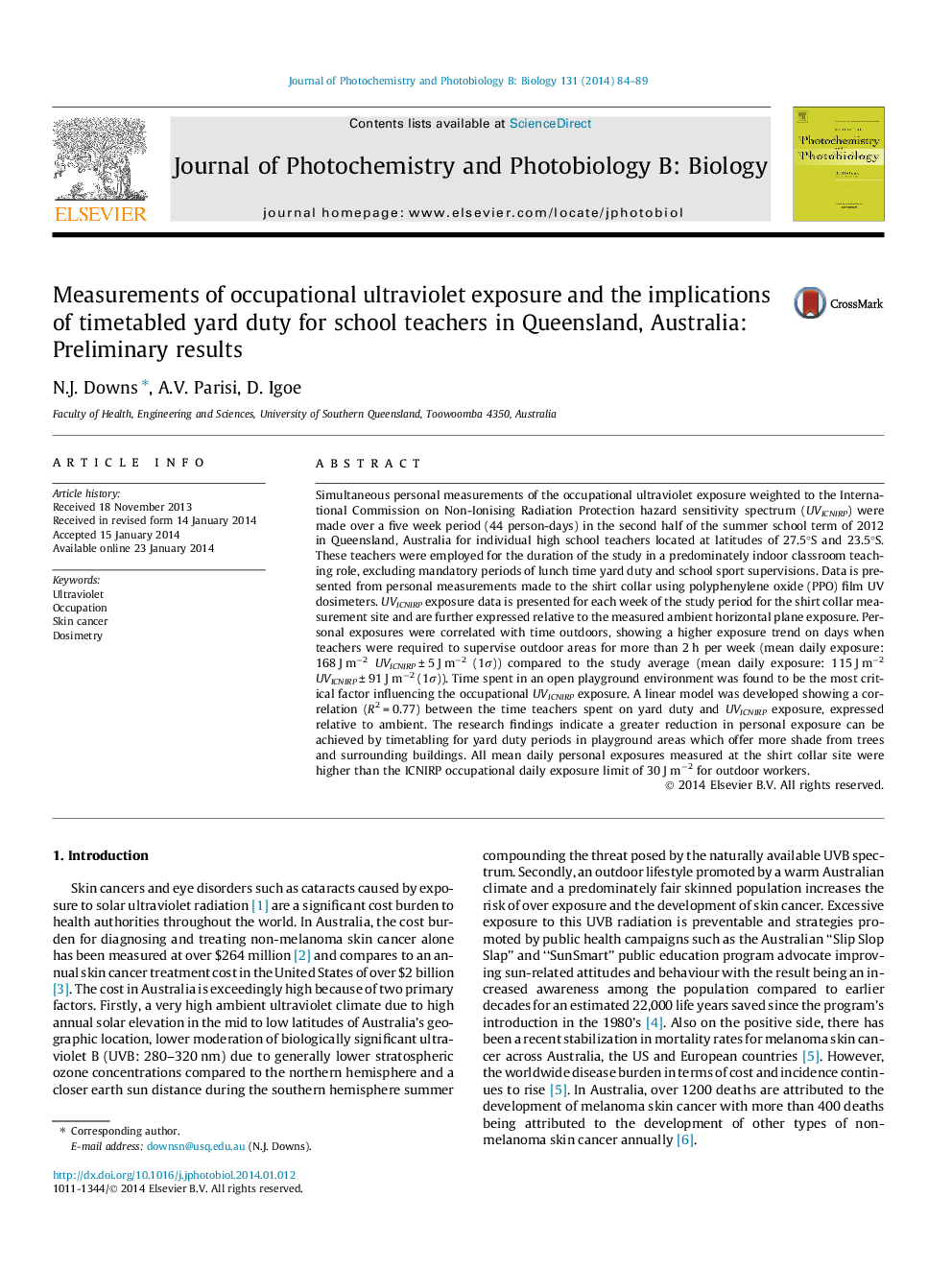| Article ID | Journal | Published Year | Pages | File Type |
|---|---|---|---|---|
| 29436 | Journal of Photochemistry and Photobiology B: Biology | 2014 | 6 Pages |
•UVB exposures measured to Queensland classroom teachers were in excess of ICNIRP guidelines.•Yard duties requiring teachers to use open playground environments have the greatest influence on cumulative exposure.•A linear model has been presented to determine ICNIRP exposure as a result of teacher yard duty time.
Simultaneous personal measurements of the occupational ultraviolet exposure weighted to the International Commission on Non-Ionising Radiation Protection hazard sensitivity spectrum (UVICNIRP) were made over a five week period (44 person-days) in the second half of the summer school term of 2012 in Queensland, Australia for individual high school teachers located at latitudes of 27.5°S and 23.5°S. These teachers were employed for the duration of the study in a predominately indoor classroom teaching role, excluding mandatory periods of lunch time yard duty and school sport supervisions. Data is presented from personal measurements made to the shirt collar using polyphenylene oxide (PPO) film UV dosimeters. UVICNIRP exposure data is presented for each week of the study period for the shirt collar measurement site and are further expressed relative to the measured ambient horizontal plane exposure. Personal exposures were correlated with time outdoors, showing a higher exposure trend on days when teachers were required to supervise outdoor areas for more than 2 h per week (mean daily exposure: 168 J m−2UVICNIRP ± 5 J m−2 (1σ)) compared to the study average (mean daily exposure: 115 J m−2UVICNIRP ± 91 J m−2 (1σ)). Time spent in an open playground environment was found to be the most critical factor influencing the occupational UVICNIRP exposure. A linear model was developed showing a correlation (R2 = 0.77) between the time teachers spent on yard duty and UVICNIRP exposure, expressed relative to ambient. The research findings indicate a greater reduction in personal exposure can be achieved by timetabling for yard duty periods in playground areas which offer more shade from trees and surrounding buildings. All mean daily personal exposures measured at the shirt collar site were higher than the ICNIRP occupational daily exposure limit of 30 J m−2 for outdoor workers.
Graphical abstractUltraviolet exposure measurements are presented for school teachers employed in a primarily indoor working role at two Australian schools for a total of 44 person-days. Exposure monitoring was conducted by comparison with daily yard duty timetables for both open and partially shaded playground environments. Measured exposures at a rear shirt collar site were found to exceed the International Commission on Non-Ionising Radiation Protection (ICNIRP) guidelines which limit ultraviolet exposure to the skin or eye at 30 J m−2 per 8 h working day. The preliminary results indicate that the occupational requirement of playground yard duty can result in teachers exceeding the daily guidelines with open playground environments having the greatest influence on cumulative exposure. A simple linear model is presented to determine the effective ICNIRP exposure from yard duty timetables which indicate time spent in both open and partially shaded playground regions.Figure optionsDownload full-size imageDownload as PowerPoint slide
